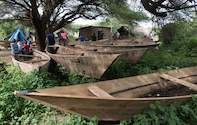
The history of human habitation in Tanzania goes back almost 2 million years, and the fossils found at Olduvai Gorge by Louis and Mary Leakey now stand among the most important artifacts of the origins of our species.
Artefacts of later Paleolithic cultures have also been found in Tanzania. The unearthing by Louis Leakey of 'Nutcracker Man', indicates that Tanzania has been the scene of human habitation since the dawn of mankind. This discovery at Olduvai Gorge is amongst the oldest human fossils ever found.
More recently during the 1st millennium AD, Bantu immigrants from the north brought with them iron workings and pottery-making skills. Active colonisation began in the 8th century in Kilwa and Zanzibar with Arabs from Oman. Two centuries later Persians arrived on the coast and built prosperous stone cities of which remnants are still visible. In Tanzania's interior, at about the same time, the cattle-grazing Maasai migrated south from Kenya into central Tanzania.
There is evidence that communities along the Tanzanian coast were engaging in overseas trade by the beginning of the first millennium AD. By 900 AD those communities had attracted immigrants from India as well as from southwest Asia, and direct trade extended as far as China. The 11th and 12th centuries saw the evolution of the Swahili language from the intermarriage of Africans, Arabs, and Persians. Trade quickly developed in ivory, Rhino horn and coconut oil.
Trading flourished in the 19th century with copper and gold from the interior and the notorious slave trade. When the Portuguese arrived at the end of the 15th century, they found a major trade centre at Kilwa Kisiwani, which they promptly subjugated and then sacked. The Portuguese were expelled from the region in 1698 after Kilwa enlisted the help of Omani Arabs. The Omani dynasty of the Bu Said replaced the region's Yarubi leaders in 1741, and they proceeded to further develop trade.
It was during this time that Zanzibar gained its legendary status as a centre for the ivory and slave trade, becoming in 1841 the capital city of the sultan of Oman. Reports from early European explorers and missionaries led to the Sultan Baighash of Zanzibar being forced to outlaw slavery in 1873. Along the coastal regions, however, it continued illegally until colonial times. Soon afterwards the great age of European exploration of the African continent began, and with it came colonial domination.
In 1886 the mainland was declared a protectorate of German East Africa and Zanzibar became a British protectorate. After World War I, the Germans were expelled and East Africa came under a League of Nations Mandate to the British, who renamed it Tanganyika. After gaining independence in 1961, Tanganyika was proclaimed a Republic within the British Commonwealth the following year.
Tanganyika and Zanzibar united in 1964 to become the United Republic of Tanzania. (Present-day Tanzania is the result of a merger between the mainland, Tanganyika, and Zanzibar after both had gained independence). Tanzania has like many African nations experienced considerable strife since independence, and its economy is extremely weak. However, political stability does appear to have been established in recent years.
Chagga
The Chagga live on and around Mount Kilimanjaro. The Chagga are expert farmers and coffee growers. Indeed, this valuable export crop has become the main source of their wealth. One of the most fascinating aspects of traditional Chagga life is the use of water resources for irrigation.
Kilimanjaro is the source of many rivers and the Chagga long ago developed a system of furrows to draw off the water at high levels and divert it over long distances. The irrigation system makes the Chagga homestead a lush garden. Seventeen varieties of banana grow on Kilimanjaro and these provide the staple element of the Chagga diet.
Swahili
Swahili is the name given not only to East Africa's widespread language but also to some of the people living along the coast. They form a collection of tribes who share a common culture and language, but the boundaries between the Swahili and their neighbours are never definitely clear.
The Swahili do not stand alone as a distinct ethnic or tribal entity but form an element in a wider mixed coastal society. Little is known of the groups who were among their ancestors - the Diba, Debuli, and others from Persia and India.
The Swahili emerged as distinct people with their own way of life by the 12th century at the latest. They have always produced millet and rice for their own consumption, as well as coconut products and fruit.

 Better known for its wilderness areas, Tanzania nonetheless provides a rich cultural and historical aspect. Aside from the Ngorongoro Conser...
Better known for its wilderness areas, Tanzania nonetheless provides a rich cultural and historical aspect. Aside from the Ngorongoro Conser... Tanzania safari tours take you on a voyage through legends and the intrepid explorers of the past. Tanzania, the largest country in East Afr...
Tanzania safari tours take you on a voyage through legends and the intrepid explorers of the past. Tanzania, the largest country in East Afr...